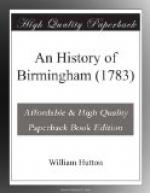John was the fruit of this unlawful amour, whose guardian, to prevent his inheriting the estate, made him a canon of Ouston, in Leicestershire; and afterwards persuaded the unhappy Margery to grant the manor to the abbot of Stonely.
Thomas de Beauchamp, Earl of Warwick, afterwards purchased it for 133_l_. 6s. 8d. It came to the crown by attainder, in the reign of Henry the Seventh; then to Sir William Staunford, one of his judges, John Buttler; Edward Holte, in 1568; Francis Dimock, whose daughter married Walter Earl; then to Walter Devereux, by marrying Earl’s daughter; afterwards to Sir Thomas Holte, by purchase; and is now in the family of Bagot.
Though the hall is antique, its front is covered in the modern barbarous stile, by a clump of venerable trees; which would become any situation but that in which they stand. It is now inhabited by a gentleman of Birmingham, who has experienced the smiles of commerce.
ASTON.
Two miles north of Birmingham, is Aston (East-town) being east of Westbury (Wednesbury) it lies on a steep descent towards the river Tame.
This place, like that of Erdington, belonged to the Earls of Mercia in the Saxon times; and, at the conquest, was the property of the unfortunate Edwin. Fitz-Ausculf became his successor in this, and in other lands: the survey calls it eight hides, valued at 5_l_. per annum; a mill, 3s. and a wood, three miles long, and half a mile broad. The mill, I make no doubt, stood where a mill now stands, near Sawford-bridge; but neither the hides, nor the wood, could be confined within the boundary of Afton; the manor is too little for either. The lordship extends about a square mile, and that part which is now the park, I have reason to think, was then a common, and for ages after.
A Saxon, of the name of Godmund, held it under the Mercian Earls, and found means, at the conquest, to hold it under the Norman.
One hundred yards north of the church, in a perfect swamp, stood the hall; probably erected by Godmund, or his family: the situation shews the extreme of bad taste—one would think, he endeavoured to lay his house under the water. The trenches are obliterated by the floods, so as to render the place unobserved by the stranger: it is difficult to chuse a worse, except he had put his house under the earth. I believe there never was more than one house erected on the spot, and that was one too much.
Whether this Saxon family of Godmund became extinct, or had lost their right, is uncertain; but Sumeri, Fitz-Ausculf’s successor, about 1203, granted the manor to Sir Thomas de Erdington, Ambassador to King John, mentioned before, who had married his sister; paying annually a pair of spurs, or six-pence, as a nominal rent, but meant, in reality, as a portion for the lady.




